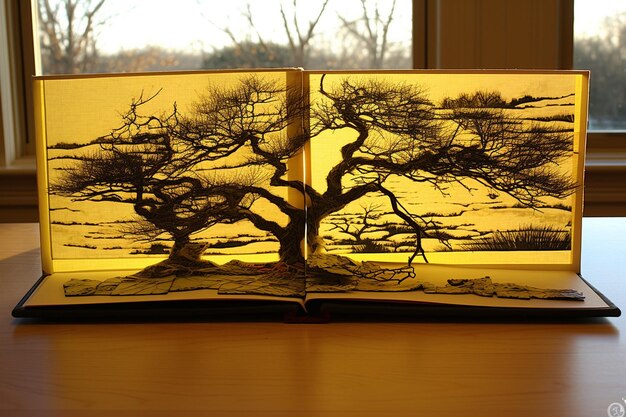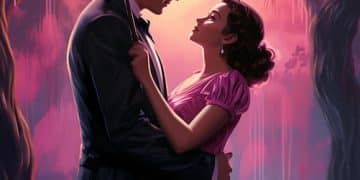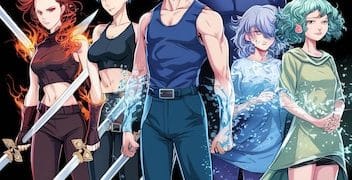J-Drama Adaptations of Literary Classics: A Comprehensive Comparison

J-Drama Adaptations of Literary Classics: A Comparison of various series reveals fascinating insights into cultural interpretation, narrative adjustments, and the unique ways Japanese television brings timeless stories to life, creating engaging viewing experiences.
Japanese television dramas, known as J-dramas, have a rich history of adapting literary classics into captivating visual narratives. This article delves into a J-Drama Adaptations of Literary Classics: A Comparison of various series, exploring the artistic choices, cultural nuances, and critical receptions that shape these adaptations.
Exploring the World of J-Drama Adaptations
J-dramas often draw inspiration from literature, breathing new life into well-loved stories. These adaptations provide a unique opportunity to examine how classic themes and characters are reinterpreted through a Japanese lens. We will explore the reasons behind these adaptations and their impact on the audience.
Why Adapt Literary Classics?
Adapting literary classics allows J-dramas to tap into pre-existing fan bases and leverage familiar narratives. It provides a foundation for creative storytelling while introducing these works to a new generation of viewers.
- Broad appeal: Classic literature resonates with a diverse audience, providing a wide reach for J-dramas.
- Creative freedom: Adaptations allow writers and directors to put their own spin on familiar stories, creating something new and exciting.
- Cultural relevance: Adaptations can explore cultural themes and values, making the stories more relatable to Japanese audiences.
The Challenges of Adaptation
Adapting literary classics is not without its challenges. Writers must strike a balance between staying true to the source material and making changes necessary for the visual medium. Character development, pacing, and plot structure all require careful consideration. Ensuring that the essence of the original work is maintained while creating an interesting and engaging TV series can be difficult.
Ultimately, the success of a J-drama adaptation depends on how well it captures the spirit of the original work while appealing to a modern audience. Adaptations can introduce viewers to the pleasure of reading classic literature and create a long-lasting impact on popular culture, particularly when they inspire interest in reading books after watching the adaptation.
Analyzing Narrative Adjustments in J-Dramas
When literary works are adapted into J-dramas, narrative adjustments are commonly made to suit the format, audience, and cultural context. These might include changes in character arcs, pacing, and even plot points. Let’s examine these variations and their impact.
Character Transformations
Characters in J-drama adaptations can undergo significant transformations. These changes can be motivated by the need to modernize the narrative, make the characters more relatable to contemporary audiences, or align with Japanese cultural norms and expectations.
For instance, a character known for their stoicism in the original novel might be given more emotional depth in the J-drama adaptation. This change can help viewers connect with the character on a deeper level, while still retaining the essence of their personality. It ensures a solid bond with the audience.
Pacing and Structure
J-dramas typically have a limited number of episodes, necessitating adjustments to the pacing and structure of the original story. Some plot points might be condensed, while others are expanded upon to fill the available screen time. The goal is to maintain the essence of the story while creating a compelling viewing experience.
- Condensing subplots: Minor storylines might be cut or simplified to streamline the narrative.
- Adding new scenes: New scenes can be added to flesh out characters or explore themes in greater detail.
- Adjusting the timeline: The timeline of the story might be altered to fit the format of a J-drama, creating a more satisfying viewing experience.
Some adaptations also choose to tell the story out of order to keep the audience guessing. Changes to pacing and structure are vital to keep viewers engaged and enthusiastic. Balancing these modifications with respect for the source material is a sign of a good adaptation.
Cultural Interpretations in J-Drama Adaptations
Adapting literary classics into J-dramas involves incorporating unique cultural interpretations. Japanese values, social norms, and historical context influence how these stories are told and interpreted.
Reflecting Japanese Values
J-dramas often reflect Japanese cultural values such as harmony, respect for elders, and the importance of family. These values can be woven into the narrative, affecting character motivations, relationships, and the overall message of the story.
For example, stories that emphasize communal harmony over individual ambition are common in J-dramas. Additionally, the honor and responsibility that come with family ties often play a key role in shaping the characters’ choices. These cultural values reflect the importance of community in their culture, and how that impacts character development.
Modernizing Historical Context
When adapting historical classics, J-dramas often incorporate elements of modern Japanese culture. This can involve updating the setting, language, and costumes to make the story more relatable to contemporary audiences.
- Updated settings: Historical dramas might be set in contemporary Tokyo, blending traditional and modern elements.
- Modern language: The dialogue might be updated to reflect modern Japanese speech patterns, making it easier for viewers to understand.
- Contemporary costumes: Characters might wear contemporary clothing or updated versions of traditional costumes.
These cultural interpretations add depth and richness to J-drama adaptations, creating a more engaging and meaningful viewing experience. These cultural elements keep the feel and overall lesson of the adapted work. By changing the context, J-dramas can bring those messages to new audiences.

Case Studies: Successful J-Drama Adaptations
Examining specific examples of successful J-drama adaptations can provide valuable insights into what makes these series work. By looking at critically acclaimed and popular series, we can see the elements that contribute to their success.
“Nodame Cantabile”
Based on the manga of the same name, “Nodame Cantabile” follows the story of a gifted but eccentric pianist and a talented conductor. The J-drama adaptation captures the humor, heart, and musical brilliance of the original series. The show quickly became a fan favorite, garnering critical acclaim for its cast, direction, and music.
The adaptation successfully translated the manga’s unique art style and comedic timing to the screen, while also adding its own spin on the story through thoughtful character development and a fantastic soundtrack. “Nodame Cantabile” exemplifies how a J-drama adaptation can maintain the essence of the source material while creating something new and exciting.
“Ryoma den”
This historical drama chronicles the life of Sakamoto Ryoma, a pivotal figure in the Meiji Restoration. “Ryoma den” earned praise for its historical accuracy, compelling storytelling, and stunning cinematography. The show succeeded in bringing a complex historical period to life, while also exploring themes of loyalty, honor, and sacrifice.
- Accurate portrayals: The show’s attention to historical detail helped create an immersive viewing experience.
- Compelling characters: The characters were nuanced and complex, making viewers care about their fates.
- Thoughtful themes: The show explored deep themes about the complexities of historical events.
By focusing on the personal struggles and triumphs of its characters, “Ryoma den” made history accessible and engaging for a wide audience. It demonstrates how a J-drama adaptation can honor its source material while creating a compelling and relevant narrative that resonates with contemporary viewers.
Critical Reception and Audience Response
J-drama adaptations often receive mixed reactions from critics and audiences. Some viewers praise the adaptations for their creativity and faithfulness to the source material, while others criticize them for straying too far from the original story.
Critical Acclaim
Many J-drama adaptations have garnered critical acclaim for their acting, directing, writing, and overall production quality. Critics often commend the series for their ability to capture the spirit of the original work while adding their own unique spin, making it an enjoyable visual experience.
The critical success depends on how well the adaptations balance the visual and narrative elements, combining compelling performances, thoughtful direction, and well-crafted writing. By achieving this harmony, J-dramas can not only entertain audiences but also earn the respect and admiration of critics. This respect leads to more future adaptations being made.
Fan Reactions
Audience reactions to J-drama adaptations vary widely, depending on personal preferences and expectations. Some fans appreciate the creativity and originality of the adaptations, while others feel that they should stay closer to the source material. These differences in opinion can lead to passionate debates and discussions within the fan community.
- Loyalty to the source material: Some fans want adaptations to be faithful to the original story.
- Adaptation as interpretation: Other fans view adaptations as a reinterpretation of the source material.
- Expectations matter: A viewer’s expectations matter in how they review the show.
Ultimately, the success of a J-drama adaptation depends on its ability to engage and entertain viewers, regardless of their expectations or preferences. Adaptations that can strike a balance between honoring the source material and creating something new and exciting are likely to be well-received by audiences and critics alike. This blend will help keep audiences interested.
The Future of J-Drama Adaptations
The future of J-drama adaptations looks bright. With a wealth of literary classics to draw from, there is no shortage of material for writers and directors to explore. As technology continues to evolve, we can expect to see even more creative and innovative adaptations in the years to come.
Emerging Trends
Several emerging trends are shaping the future of J-drama adaptations. These include the use of advanced technology, the increasing popularity of streaming services, and the growing global audience for Japanese television.
Technological advancements, such as virtual reality and artificial intelligence, will enable J-dramas to create more immersive and engaging experiences for viewers. The rise of streaming services will allow these series to reach a wider global audience, introducing new viewers to the world of Japanese television. With more and more people watching foreign shows, and more technology becoming available, J-dramas can only become more popular around the world.
Potential Challenges
Despite the promising outlook, there are also potential challenges facing J-drama adaptations. These include the need to balance creativity with faithfulness to the source material, the pressure to appeal to a global audience, and the ever-increasing competition from other forms of entertainment.
To overcome these challenges, J-dramas must continue to innovate and experiment, while also staying true to their unique cultural identity. By embracing new technologies and approaches, while also honoring their deep-rooted traditions, J-drama adaptations can thrive in the years to come. It is important to strike that balance of new and traditional.
| Key Point | Brief Description |
|---|---|
| 📚 Source Material | J-dramas adapt literature to gain appeal and provide a foundation for storytelling. |
| 🎬 Narrative Changes | Charater arcs and plots may be adjusted to better fit in a J-drama adaptation. |
| 🎎 Cultural Impact | Adaptations incorporate Japanese values and adjust historical context for modern viewers. |
| 🎉 Audience | Fan reaction varies, but most prefer when adaptations remain true to source material. |
Frequently Asked Questions
▼
Literary classics are adapted into J-Dramas to leverage popular narratives, introduce timeless stories to new audiences, and provide a strong foundation for creative storytelling while tapping into familiar themes and characters.
▼
Common narrative adjustments include alterations to character arcs, pacing adjustments to fit episode counts, and adjustments that modernize the context for the audience. Keeping the narrative aligned with expectations keeps people involved.
▼
J-Dramas incorporate Japanese cultural values by reflecting societal norms, showing respect for elders, and displaying the importance of family, adjusting character relationships and plot developments to emphasize these values.
▼
Yes, many J-Dramas modernize historical context to make them more relatable to audiences. Modern updates can have characters wearing contemporary clothing and using modern speech patterns in order to relate to the audience.
▼
For successful J-Drama adaptations, they must accurately portray the source material, tell a compelling story, perform with stunning cinematics, and maintain the themes within the source material. If all is done than success is achievable.
Conclusion
J-drama adaptations of literary classics offer a unique blend of storytelling, cultural interpretation, and artistic expression. Comparing various adaptations highlights the creative choices and challenges involved in bringing these timeless stories to the screen. As J-dramas continue to evolve, they will undoubtedly find new and innovative ways to captivate audiences while honoring the spirit of the original works.





